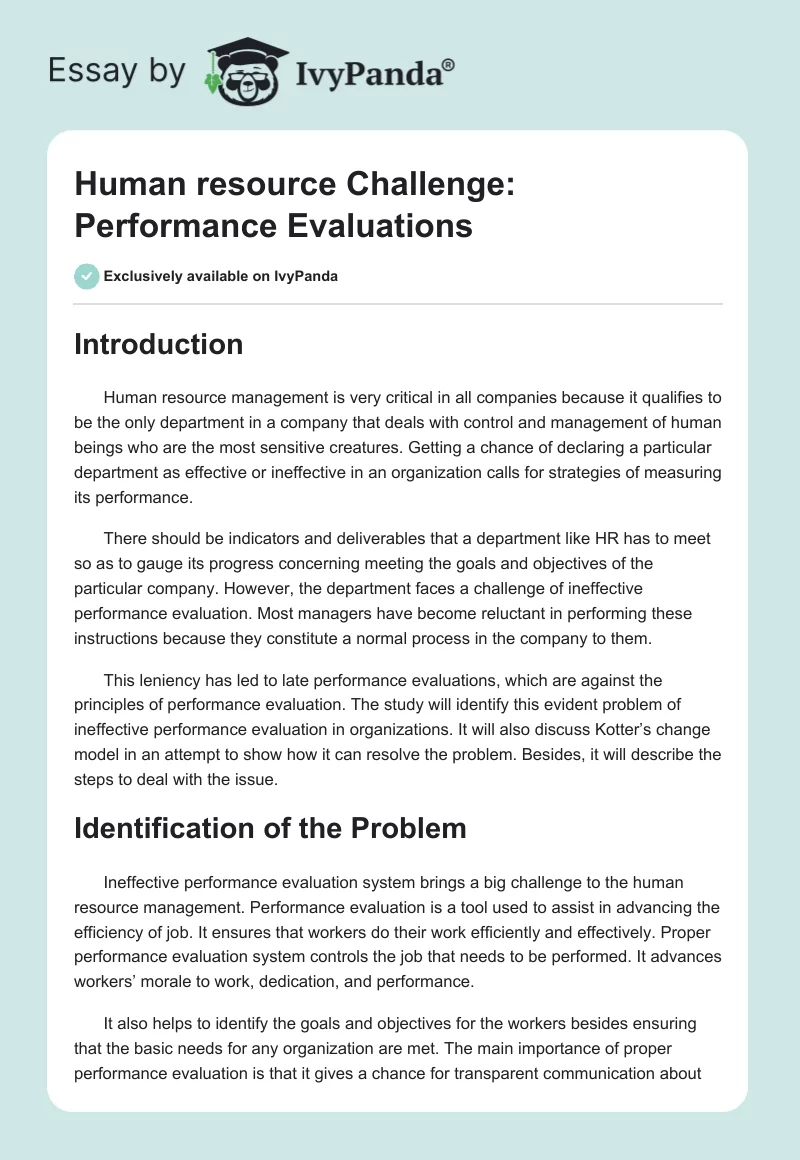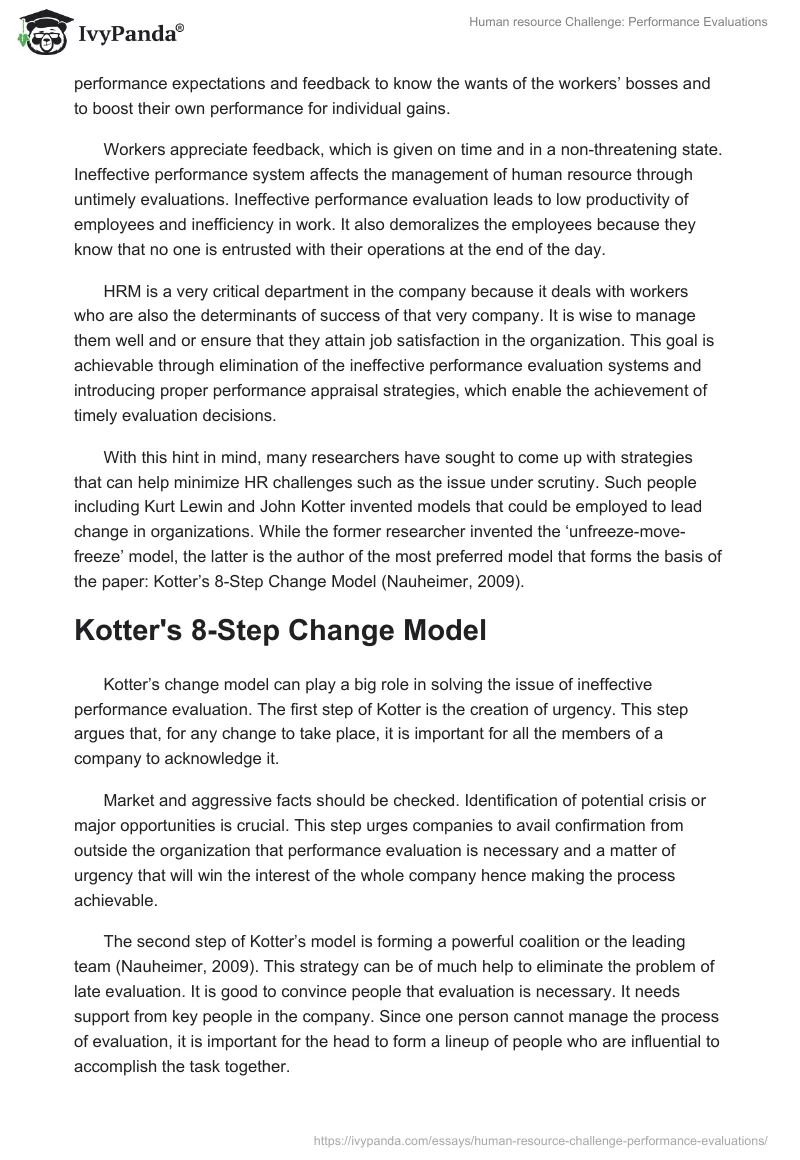Introduction
Human resource management is very critical in all companies because it qualifies to be the only department in a company that deals with control and management of human beings who are the most sensitive creatures. Getting a chance of declaring a particular department as effective or ineffective in an organization calls for strategies of measuring its performance.
There should be indicators and deliverables that a department like HR has to meet so as to gauge its progress concerning meeting the goals and objectives of the particular company. However, the department faces a challenge of ineffective performance evaluation. Most managers have become reluctant in performing these instructions because they constitute a normal process in the company to them.
This leniency has led to late performance evaluations, which are against the principles of performance evaluation. The study will identify this evident problem of ineffective performance evaluation in organizations. It will also discuss Kotter’s change model in an attempt to show how it can resolve the problem. Besides, it will describe the steps to deal with the issue.
Identification of the Problem
Ineffective performance evaluation system brings a big challenge to the human resource management. Performance evaluation is a tool used to assist in advancing the efficiency of job. It ensures that workers do their work efficiently and effectively. Proper performance evaluation system controls the job that needs to be performed. It advances workers’ morale to work, dedication, and performance.
It also helps to identify the goals and objectives for the workers besides ensuring that the basic needs for any organization are met. The main importance of proper performance evaluation is that it gives a chance for transparent communication about performance expectations and feedback to know the wants of the workers’ bosses and to boost their own performance for individual gains.
Workers appreciate feedback, which is given on time and in a non-threatening state. Ineffective performance system affects the management of human resource through untimely evaluations. Ineffective performance evaluation leads to low productivity of employees and inefficiency in work. It also demoralizes the employees because they know that no one is entrusted with their operations at the end of the day.
HRM is a very critical department in the company because it deals with workers who are also the determinants of success of that very company. It is wise to manage them well and or ensure that they attain job satisfaction in the organization. This goal is achievable through elimination of the ineffective performance evaluation systems and introducing proper performance appraisal strategies, which enable the achievement of timely evaluation decisions.
With this hint in mind, many researchers have sought to come up with strategies that can help minimize HR challenges such as the issue under scrutiny. Such people including Kurt Lewin and John Kotter invented models that could be employed to lead change in organizations. While the former researcher invented the ‘unfreeze-move-freeze’ model, the latter is the author of the most preferred model that forms the basis of the paper: Kotter’s 8-Step Change Model (Nauheimer, 2009).
Kotter’s 8-Step Change Model
Kotter’s change model can play a big role in solving the issue of ineffective performance evaluation. The first step of Kotter is the creation of urgency. This step argues that, for any change to take place, it is important for all the members of a company to acknowledge it.
Market and aggressive facts should be checked. Identification of potential crisis or major opportunities is crucial. This step urges companies to avail confirmation from outside the organization that performance evaluation is necessary and a matter of urgency that will win the interest of the whole company hence making the process achievable.
The second step of Kotter’s model is forming a powerful coalition or the leading team (Nauheimer, 2009). This strategy can be of much help to eliminate the problem of late evaluation. It is good to convince people that evaluation is necessary. It needs support from key people in the company. Since one person cannot manage the process of evaluation, it is important for the head to form a lineup of people who are influential to accomplish the task together.
The third step in Kotter’s model is the formulation of a vision for change. This step is very vital in performance evaluation. It enables people to remain focused to the process of evaluation. Many great ideas and solutions start flowing around when mangers have the change they need at heart.
Therefore, for the evaluation to be grasped and remembered by the managers, it has to be linked to the overall vision. Companies need to see the essence of timely evaluations relative to their goals and objectives. An untimely evaluation might lead to the closure of an organization especially if the evaluation reveals that the company is out of track. The whole issue will be blamed to HR. Moreover, a plan to implement the vision of the evaluation process should be created.
This plan will ensure that the vision is achieved. After the creation of the vision, it is advisable to communicate the vision. According to Kotter’s model, success in the company is determined by what is done with the vision after it is thought of by the managers. As Nauheimer (2009) posits, managers should communicate and talk about the vision of the performance evaluation in every available chance to enable members to consider timely evaluation a priority.
Every need to administer a change in an organization faces oppositions from those who might not be for the change. Such oppositions cite reasons such as finance and timing as obstacles behind the change. Kotter’s fifth step therefore addresses the removal of such obstacles or rather coming up with an empowering strategy (Nauheimer, 2009).
This step is very crucial in performance evaluation because it recognizes and awards all people in the company who support performance evaluation to enable them continue with the morale. It also helps in removal of the barriers, which hinder the vision of performance evaluation from being achieved.
Formation of short-lived wins as a step in Kotter’s change model assists in the issue of performance evaluation because an overall evaluation vision may take long to be realized hence discouraging people. It is advisable to let the staff see the results of the change and feel the victory of the evaluation process in the shortest period.
After ensuring that the staff people experience short-term wins, building the change should be considered a priority at this stage. Kotter’s seventh step believes that true change runs deep because most of the projects tend to collapse due to an early declaration of victory. It is therefore important to analyze what has to be improved and or what went right after every success to ensure that the performance evaluation is following the right track.
The last Kotter’s step is to fasten the changes in a business culture (Nauheimer, 2009). This strategy is very beneficial in the performance evaluation because it will ensure that performance evaluation becomes one of the values in the company, and that it will always remain in the minds of every staff member hence ensuring sustainability of the performance evaluation.
The steps to be taken to deal with the issue of ineffective performance evaluation system
There are several steps, which should be taken to ensure that there is effective performance evaluation. The first step is the reviewing of progress whereby the HR should look at the previous evaluation for deficiencies in performance in an attempt to confirm if they have been corrected or whether they continue to be a problem. If they continue to be an issue, they have to be noted in the evaluation to enable the creation of urgency for the continued problems as elaborated by the Kotter’s change model.
The next step in conducting effective performance is the analysis, which is important for identification of gaps between the anticipated and actual performance. After the identification of the training need, a leader can form a coalition or a team, which enables him or her to execute the evaluation process. The next step in effective performance evaluation is analyzing the root of the gaps.
Actual performance falls short of expected performance and that management assumes that employees must try harder. It is very important “to analyze the reason for a gap between the expected and the actual performance” (Nauheimer, 2009). This information will enable development of the performance evaluation vision, which will always guide the staff member to remain dedicated to the process of evaluation.
After the analysis of the causes of the gaps, the following step is the evaluation meeting. The meeting should be scheduled with employees in the performance evaluation. At this meeting, employees should be at ease. The evaluation vision is communicated and employees’ views listened to and put into consideration. Strategies and tactics to be used in the performance evaluation should be well tested.
It is important to note that not all performance evaluation methods work equally well in every organization. One should consider the class of workers to be appraised i.e. “managers vs. non-managers, the types of jobs they perform, the nature of the relationship between employees and managers, and the purpose the evaluation intends to serve” (Nauheimer, 2009).
Conclusion
In conclusion, ineffective performance evaluation attracts a very great challenge to human resource through untimely appraisals and late evaluation decisions. However, this paper has discussed Kotter’s change model and its implications in the improvement of the performance evaluation system.
The paper has also discussed the steps, which will be involved in coming up with an effective performance evaluation. After the application of the steps, a company will be able to experience successful change and never to experience any other late evaluations. This paper has focused on performance evaluation management, which will ensure that there are zero late performance evaluations moving forward.
This management process will induce companies to come up with better performance evaluation systems, which will enable managers to do the performance evaluations on time hence enabling the HR management department also to organize the employees in a better and recommendable way. It will also be beneficial to the company at large because the weakest worker of that the company determines its strength. Moreover, a company is made up of employees. If they are well managed, there is a high and efficient productivity.
Reference
Nauheimer, H. (2009). Change Model 3: John Kotter’s 8 Steps of Leading Change. Web.



